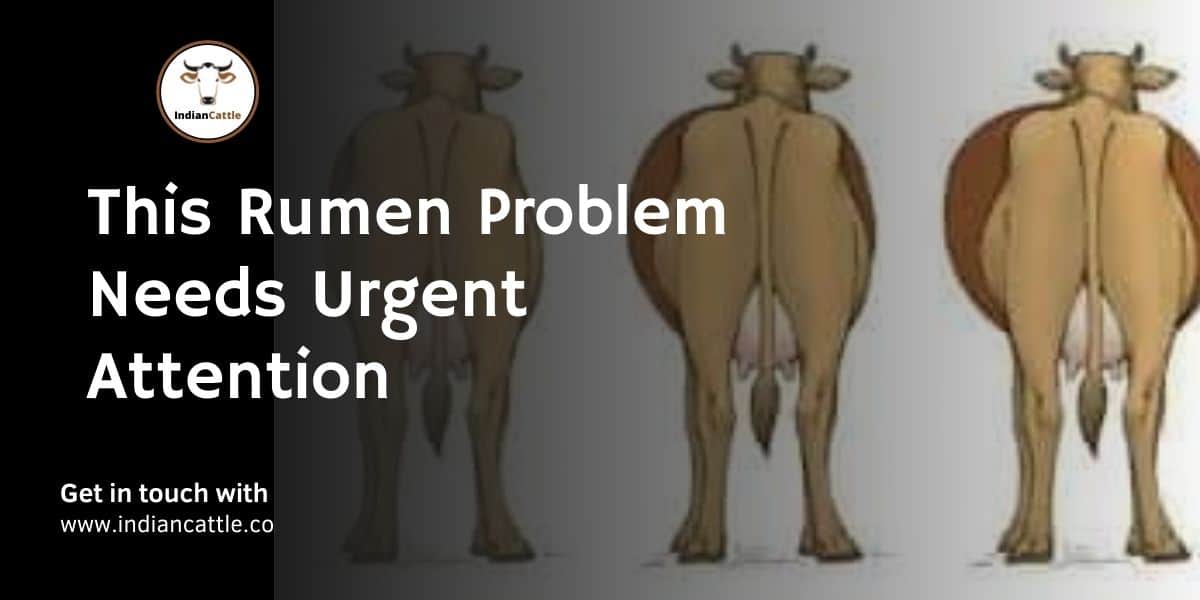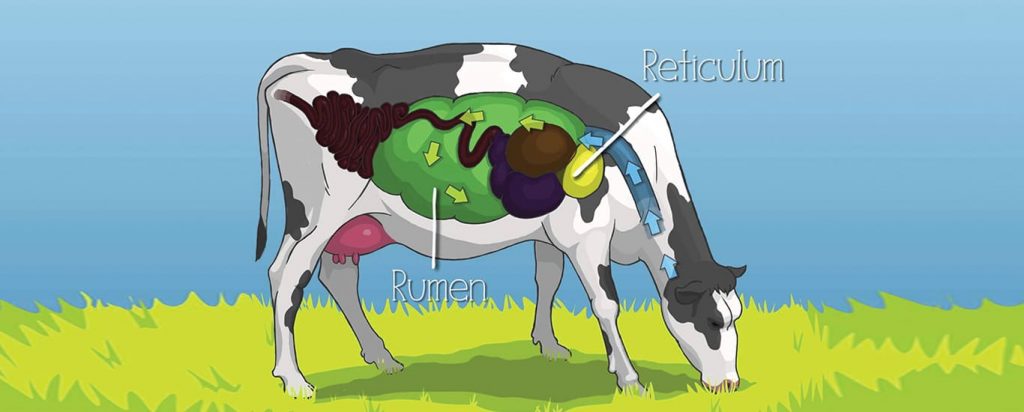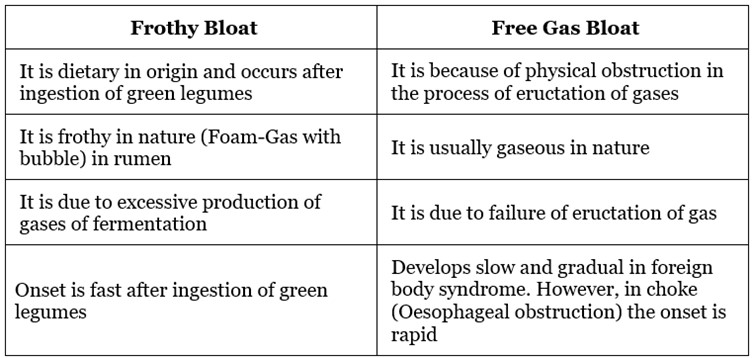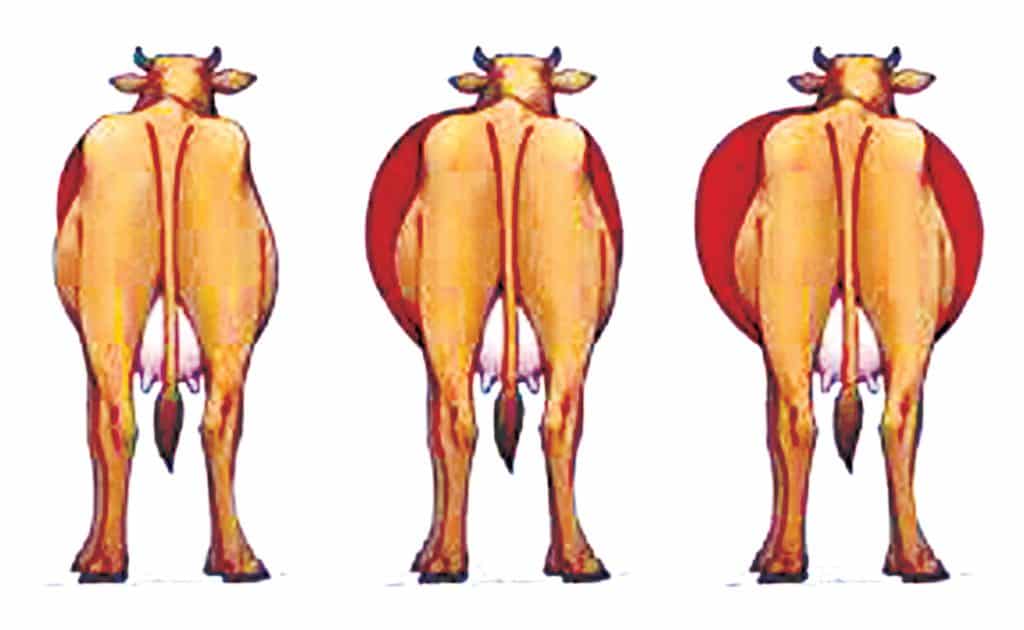
An Overview on Bloat in Ruminant And Its Management
Bloat (Ruminal Tympany)
Bloat is abnormal distention of rumen and reticulatum caused by excessive accumulation of gases of fermentation which either mixed with ingesta or as a free gas separated by ingesta. Bloat is simply building up gas in the Rumen. The nature of digestion process in cattle create the production of large quantities of gases like carbon dioxide and methane in rumen. Gas production is normal process as a result of fermentation in rumen. The gas is usually discharged or released through eructation (Belching). However, if the cattle is unable to remove excess gas, the pressure build up in rumen-reticulatum creating more pressure on diaphragm and bloat occurs. In cattle, the bloat occurs in two types VIZ; Primary (Frothy Bloat) and Secondary (Free Gas Bloat).

A) Frothy Bloat:
Frothy bloat is dietary in origin and occurs in cattle after ingestion of leguminous pastures. Hence this is also termed as feedlot bloat observed in rainy seasons. It is reported that excessive ingestion of large amounts of green leguminous plants develops stable foam that increases the viscosity of ruminal fluid and prevents release of gas adhered to ingesta.
Bloat occurs when eructation mechanism is impaired or inhibited. The rate of gas production sometimes exceeds the animal’s ability to expel the gas. Intake of excessive green and leguminous plants will cause stable foam or froth in rumen along with gases of fermentation. The plant contains protein especially in their leaf cytoplasm that has got tremendous gelling property. Besides that there are Saponin, Pectin, and hemicellulose content in the plants helps in the production of stable foam in the rumen and thereby impair eructation process. Accumulation of gases will stimulate ruminal contraction initially and later on cause atony of the rumen.
B) Free Gas Bloat:
Free Gas Bloat occurs as a result of physical obstruction in eructation process caused by Choke (Esophageal obstruction), oesophagitis, stenosis of esophagus, traumatic reticulo-peritonitis (TRP), diaphragmatic hernia and vagal Indigestion. These factors may cause interference with nerve pathway responsible for maintenance of eructation reflex. The reason of development of this condition is due to inhibition of nerves controlling contraction of ruminal wall and or physical obstruction of esophagus.
Difference between Frothy and Free Gas bloat

Clinical Manifestations:
Anorexia, distention of left paralumbar fossa, signs of colic, kicking at belly, looking at flank, rolling on ground. Drum like resonance sound on percussion of left paralumbar fossa, marked dyspnea due to intrathoracic pressure, increase in heart and respiration rate, ruminal atony, dehydration, reduced output of the urine, mucus membrane sometimes become cyanotic due to insufficient oxygen, constipation followed by diarrhea. The onset of primary (frothy) bloat is fast whereas free gas bloat develops slowly and persist for long time. Sometime if the cases of bloat not treated, death might occur due to aspexia.
Diagnosis Approach: Distention of left flank with drum like resonance on percussion. In frothy bloat, passing of stomach tube can find out presence of froth in rumen. However, in free gas bloat, proper history will help to rule out whether the bloat is suddenly developed or occurring from several days (recurrent tympany) as it is associated with physical obstruction in eructation process. In free gas bloat, radiographic examination is quiet helpful to rule of cause in case of any foreign body.

The cases of bloat can be differentially diagnosed with esophagus obstruction (Choke), TRP, Traumatic pericarditis, Diaphragmatic hernia and vagal indigestion
Line of the treatment:
Veterinary Clinicians need to identify the type of the bloat whether it is frothy or free gas type and treat it accordingly. Feed and water intake of the animal to be avoided. The wooden stick is to be kept in mouth to promote salivation.
The carminative mixture are advised to give to the animal as first aid. Field Veterinarians usually prefer preparation containing Simethicone and Dil oil (Bloatosil) as a drench 100-200 ML depending upon body weight of the animal. Simethicone is an anti-foaming agent that works as surfactant that breaks water bubble and Dil oil acts as a carminative helping for easy eructation of gases. Simethicone can relieve pain caused by gas in the rumen by decreasing foaming, which then allows for easier passing of flatulence.
In few emergency cases, trochar and cannula to be punched through the side into the rumen will relieve gassy bloat when a stomach tube has not worked. But such cases are rare, and as the trochar may provide a tremendous opportunity for the introduction of infection, it should only be used as an emergency option only. Recurrent tympany/bloat once confirmed through Radiographic examination as Traumato-reticuloperiotonitis (TRP) need to undergo surgical procedure of Rumenotomy to relieve the animal from physical obstruction of foreign body. Bloat cases associated with acidosis caused due to high carbohydrate diet need to be treated with intravenous fluids, sodium bicarbonates and antihistaminic drugs as per need.
Dr. Vijay Muley
Head (Marketing)-Veterinary Division
Vetoquinol India Animal Health P. Ltd, Mumbai
